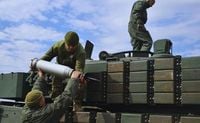On September 30, 2025, the European Commission made a striking announcement: it would allocate €2 billion to Ukraine for the production of drones, aiming to bolster the country’s defensive capabilities and foster advanced technology development. President of the European Commission Ursula von der Leyen said the funding would not only help Ukraine scale up its drone production but also allow the European Union to benefit from these emerging technologies. "A total €2 billion will be spent on drones now," von der Leyen stated, emphasizing the dual purpose behind the investment.
This move comes amid a dramatic surge in Ukraine’s domestic arms manufacturing. Since the onset of the full-scale war, Ukrainian weapons production has skyrocketed by a reported 35-fold, according to Ukraine’s Minister of Defence Denys Shmyhal. The country’s defense industry has not just ramped up quantity, but also pivoted to cutting-edge solutions, deploying new technologies directly to the front. The momentum is evident: in June, Ukraine’s drone production was up by a staggering 900 percent compared to the previous year, with monthly output soaring from 20,000 units in summer 2024 to more than 200,000 by September 2025, as reported by BBC.
Yet, despite these impressive gains, President Volodymyr Zelensky remains acutely aware of the scale of the challenge. In his nightly address on September 29, he convened with the nation’s drone and missile manufacturers, pressing for the “maximum production of long-range weapons.” Zelensky explained, "The key issue is production volumes." He brought together the Ministry of Defense, security forces, and all major defense companies in a coordinated push to ensure that every stakeholder had a clear, honest view of the country’s true manufacturing capacity. "These collaborations work best when everyone is in the same conversation, when all those involved in preparing important decisions who are actually affected can bring real information to the table and cannot lie," he explained, highlighting the need for transparency and realism.
It’s not just domestic efforts that are fueling Ukraine’s defense ambitions. The international community is stepping up in significant ways. Germany, for instance, recently announced a $351 million program to supply Ukraine with several thousand long-range drones, intended for deep strikes against Russian military targets. Berlin’s Defense Minister Boris Pistorius outlined the initiative earlier this month, underscoring Europe’s commitment to supporting Ukraine’s ability to defend itself—and, by extension, Europe’s eastern flank.
The United States is also weighing in. On Sunday, US Vice President JD Vance confirmed that the administration is reviewing President Zelensky’s request for the transfer of long-range Tomahawk cruise missiles, which boast a formidable range of up to 2,500 kilometers (1,550 miles). The request, discussed at a recent meeting between Zelensky and President Donald Trump on the sidelines of the UN General Assembly in New York, is seen as a direct response to what the White House characterizes as Russian President Vladimir Putin’s refusal to engage in meaningful peace talks.
Meanwhile, the prospect of receiving Saab JAS 39 Gripen fighter jets from Sweden is becoming a reality. Discussions about the transfer of these light, single-engine, supersonic multirole fighters have been ongoing since at least September 2024. Initially, Kyiv hesitated, concerned about managing two complex aircraft systems at once while rolling out its F-16 program. But by September 29, 2025, First Deputy Defense Minister Lt. Gen. Ivan Havrylyuk confirmed to BBC that Gripens would indeed be joining Ukraine’s arsenal.
Ukraine’s push for self-sufficiency and innovation in arms production has also opened up new opportunities on the world stage. In his September 29 address, President Zelensky revealed that Ukraine plans to export certain types of domestically produced weapons—those in surplus—to generate funds for the production of more urgently needed arms. "We are also working on controlled exports of our weapons—certain types that are in surplus and can indeed bring Ukraine additional funds to produce the more scarce items that are urgently needed on the front lines right now," Zelensky said. He noted that these surplus weapons, including maritime drones and anti-tank weapons, have proven highly effective in strikes deep within Russian territory.
The export strategy, first mentioned by Zelensky on September 19, is already yielding results. Agreements have been reached with four key export markets: the United States, Europe, the Middle East, and Africa. The controlled export of surplus weaponry is not just about funding—it’s about leveraging Ukraine’s rapidly growing defense sector to support both its own needs and those of its partners. Notably, Ukrainian-made interceptor drones are set to form the backbone of Europe’s planned "drone wall," a defensive project designed to protect NATO’s eastern borders, according to The Telegraph.
Ukraine’s international collaborations extend beyond exports. In July 2025, the country signed a memorandum with American company Swift Beat to expand drone production, with the aim of supplying the Armed Forces of Ukraine with drones specifically designed to intercept and destroy missiles. There’s also a joint production line for long-range drones being established with Denmark, and ongoing talks with the United States about further cooperation.
Despite these advances, Zelensky remains candid about the challenges ahead. He has repeatedly stressed that even the current, dramatically increased production rates may not be enough to match Russia’s growing supply of drones and intensifying aerial attacks. "We must produce the maximum, and our Ukrainian production capacity is still far from being filled," he said, urging continued expansion and innovation in the sector.
As Ukraine races to fill the gaps in its arsenal, the country is demonstrating a remarkable ability to adapt and innovate under pressure. The surge in domestic arms production, the strategic export of surplus weapons, and the influx of international support are all parts of a dynamic, evolving defense strategy. It’s a strategy that not only aims to secure Ukraine’s immediate future but also positions the country—and the broader region—to benefit from new technologies and strengthened alliances.
The coming months will test the limits of Ukraine’s manufacturing capacity and the resolve of its allies. But as the country leverages every available resource, both at home and abroad, it’s clear that Ukraine’s defense industry is becoming a central pillar in the ongoing struggle for security and sovereignty in Eastern Europe.


